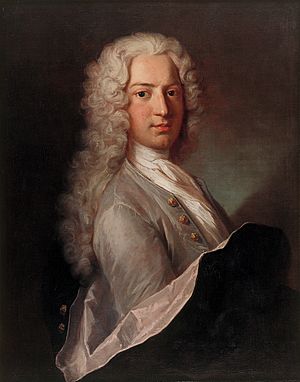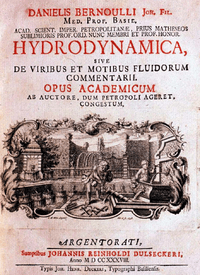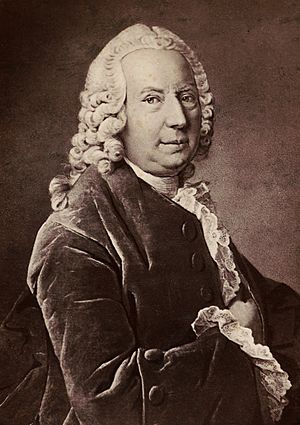Daniel Bernoulli facts for kids
Quick facts for kids
Daniel Bernoulli
|
|
|---|---|

Portrait of Daniel Bernoulli, around 1720-1725
|
|
| Born | 8 February 1700 |
| Died | 27 March 1782 (aged 82) Basel, Republic of the Swiss
|
| Education | University of Basel (M.D., 1721) Heidelberg University University of Strasbourg |
| Known for | Bernoulli's principle Euler–Bernoulli beam theory Early kinetic theory of gases Gamma function St. Petersburg paradox Superposition principle Thermodynamics |
| Scientific career | |
| Fields | Mathematics, physics, medicine |
| Thesis | Dissertatio physico-medica de respiratione (Dissertation on the medical physics of respiration) (1721) |
| Signature | |
Daniel Bernoulli (8 February 1700 – 27 March 1782) was a famous Swiss mathematician and physicist. He belonged to the Bernoulli family, which had many brilliant mathematicians.
He is best known for his work in fluid mechanics, which is the study of how liquids and gases move. His most famous discovery is called Bernoulli's principle. This idea is a key part of understanding how airplanes fly. It explains how the shape of an airplane's wing creates lift, allowing it to soar through the sky. He also did important work in probability and statistics.
Contents
A Family of Geniuses
Daniel Bernoulli was born in Groningen, Netherlands. His family was one of the most famous in the history of math and science. His father, Johann Bernoulli, was a key figure in developing calculus. His uncle, Jacob Bernoulli, was a pioneer in probability theory. With a family like that, it's no surprise Daniel became a great thinker too!
A Difficult Relationship with His Father
Daniel and his father had a rocky relationship. Once, they both entered a science contest at the University of Paris and ended up tying for first place. Instead of being proud, his father was angry. He couldn't stand the idea that his son was considered his equal and even banned Daniel from his house.
Later, his father published a book called Hydraulica that used many key ideas from Daniel's own book, Hydrodynamica. He even dated his book earlier to make it seem like he had the ideas first. Sadly, Daniel's attempts to make peace with his father never worked out.
Education and Early Career
When Daniel was young, his father wanted him to study business, thinking it was a better way to make money than mathematics. Daniel wasn't interested in business, but he eventually agreed to study medicine. In return, his father agreed to teach him mathematics privately. Daniel earned his PhD in 1721.
A Scientist's Journey
Daniel was a good friend of another great mathematician, Leonhard Euler. In 1724, he moved to St. Petersburg, Russia, to work as a professor of mathematics. However, he was not happy there. He faced several challenges and decided to leave in 1733.
He returned to Switzerland and became a professor at the University of Basel. He taught many subjects throughout his career, including medicine, metaphysics (a type of philosophy), and natural philosophy (an early term for science). He worked there for the rest of his life. In May 1750, he was elected a Fellow of the Royal Society in London, a great honor for a scientist.
Amazing Discoveries in Science
Daniel Bernoulli made many important contributions to math and physics. His work helps us understand the world around us, from the air we breathe to the way things move.
How Airplanes Fly: Bernoulli's Principle
Bernoulli's most famous work is Hydrodynamica, published in 1738. In this book, he explained a key idea now called Bernoulli's principle. The principle states that for a fluid (like air or water), when its speed increases, its pressure decreases.
This is the secret behind how airplanes fly!
- An airplane's wing is designed with a curved top and a flatter bottom.
- As the plane moves forward, the air has to travel a longer distance over the curved top than it does along the flat bottom.
- This means the air on top moves faster.
- According to Bernoulli's principle, faster-moving air has lower pressure.
- So, the pressure above the wing is lower than the pressure below it. The higher pressure underneath pushes the wing up, creating lift!
This principle is also used in things like carburetors in engines and even in sports when a player curves a ball.
Understanding Gases and Vibrations
Bernoulli was one of the first scientists to develop the kinetic theory of gases. He suggested that gases are made of huge numbers of tiny particles that are always moving and bouncing off each other. This idea helped explain Boyle's law, which describes how the pressure and volume of a gas are related.
He also studied how strings vibrate, like on a guitar or violin. His work, along with that of other scientists, helped explain the mathematics behind music and sound waves. He also developed the Euler–Bernoulli beam equation with his friend Leonhard Euler, which is very important for engineers when designing bridges and buildings.
New Ideas in Economics and Statistics
Bernoulli also applied his mathematical mind to economics. In a 1738 paper, he tackled a famous puzzle called the St. Petersburg paradox. He introduced the idea of utility, which means that the value of money depends on how much you already have.
For example, winning $100 would be a huge deal for someone with only $10 in their pocket. But for a billionaire, winning $100 would barely be noticeable. This simple but powerful idea is a cornerstone of modern economic theory.
He also used statistics in a very practical way. In 1766, he analyzed data on smallpox to show how effective inoculation (an early form of vaccination) was at saving lives. This was one of the first times statistics were used to improve public health.
Legacy
Daniel Bernoulli's ideas changed science and engineering forever. His principle of fluid dynamics is still taught to every student of physics and is essential for designing everything from airplanes to race cars. For his amazing contributions, he was inducted into the International Air & Space Hall of Fame at the San Diego Air & Space Museum in 2002.
Interesting facts about Daniel Bernoulli
- Daniel's relationship with his father, Johann, was intensely competitive and fraught with jealousy.
- Bernoulli first studied medicine and earned a doctorate. However, his true passion was mathematics, and he eventually moved into that field.
- He won the French Academy of Sciences prize 10 times. This was the most prestigious scientific award of its day.
- At the young age of 26, Daniel was appointed to the prestigious chair of mathematics at the Imperial Academy in St. Petersburg, Russia.
- Bernoulli was one of the first to argue that gases are composed of molecules in rapid, random motion and that pressure is caused by their collisions with the walls of a container.
See also
 In Spanish: Daniel Bernoulli para niños
In Spanish: Daniel Bernoulli para niños
- Bernoulli's principle
- Euler–Bernoulli beam equation
- St. Petersburg paradox
- Hydrodynamica





